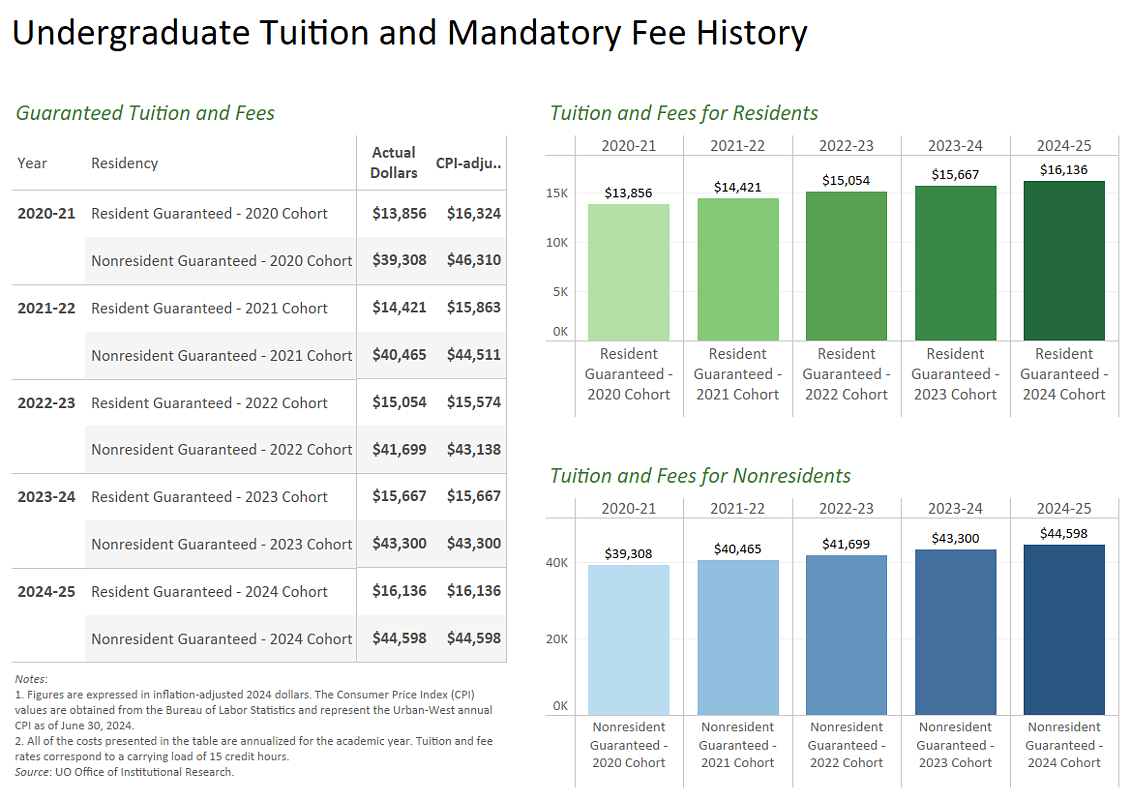The University of Oregon strives to keep tuition increases as low as possible, but the costs of operating a world-class research institution continue to increase every year.
Tuition and fees are based on residency classification, student classification (undergraduate, graduate, law, etc.) and the number of credits enrolled. Course-specific fees may also apply. For additional required fees, refer to the Class Schedule.
Read more about mandatory enrollment & course fees.
Calculating Undergraduate Tuition and Fees Tuition Cost Drivers
Undergraduate Tuition and Mandatory Fee History 2020-21 to 2024-25

1. Figures are expressed in inflation-adjusted 2024 dollars. The Consumer Price Index (CPI) values are obtained from the Bureau of Labor Statistics and represent the Urban-West annual CPI as of June 30, 2024.
2. All of the costs presented in the tables are annualized for the academic year. Tuition and fee rates correspond to a carrying load of 15 credit hours.
Source: UO Office of Institutional Research.
Paying for College
Scholarships
Private dollars can be used for scholarships, grants, and other programs that reduce the cost of tuition for students. Generous donors have already provided tens of millions of dollars in direct aid for scholarships and student support.
Scholarships are an area where the UO has made tremendous progress. Funding for need- and merit-based scholarships increased from $30.92 million in 2014-15 to $70.5 million in 2022-23, a gain of approximately $40 million.
Raising more money for such programs is one of the top priorities in the recent $1 billion extension of the UO’s capital campaign, including sustained support for PathwayOregon and more money for need- and merit-based aid.
However, donor dollars that have been given to support specific programs – such as new academic buildings, science initiatives, student centers, and classrooms – cannot be diverted for other purposes.
When donors give to a specific project it means that the gifts the university receives are restricted, and the university is legally required to use the funds for the purpose specified by the donor. The vast majority of funds that we receive from donors are restricted.
That said, gift dollars frequently pay for enhancements to our campus and our programs, thereby substantively improving the quality of every student’s experience.
PathwayOregon
The University of Oregon also recognizes the importance of helping make college a reality for low-income families.
For this reason, we have put significant resources into the PathwayOregon program, which provides full tuition and fee scholarships to Oregonians who are academically qualified, PELL-eligible, first-year freshmen. The program welcomed 645 PathwayOregon students in fall 2024.
In additional to financial support, PathwayOregon students receive intensive advising services to help them navigate college. In total, 2,219 students are currently supported by PathwayOregon (as of fall 2024). Many of the students who benefit from PathwayOregon are the first in their families to go to college or are under-represented minorities.
The university has been working hard to increase the diversity of our student population. Over the past 10 years (Fall 2014-Fall 2024), we have seen a significant increase in the percentage of undergraduate students who are students of color from 23.5% to 37.2%.
UO Giving
Online Education
The UO is committed to online learning that provides the same level of high-quality educational experience as in-classroom experiences, and we are in the process of increasing our online academic offerings.
Although it may seem counter-intuitive, online classes are often more expensive than traditional classes.
This is due to many factors including the development cost of creating online classes, the technology platforms upon which classes are offered, and the operating costs associated with these classes, particularly in classes designed to provide students with accessible support such as tutoring.
Many universities charge students extra fees on top of tuition to pay for these additional online course costs.
